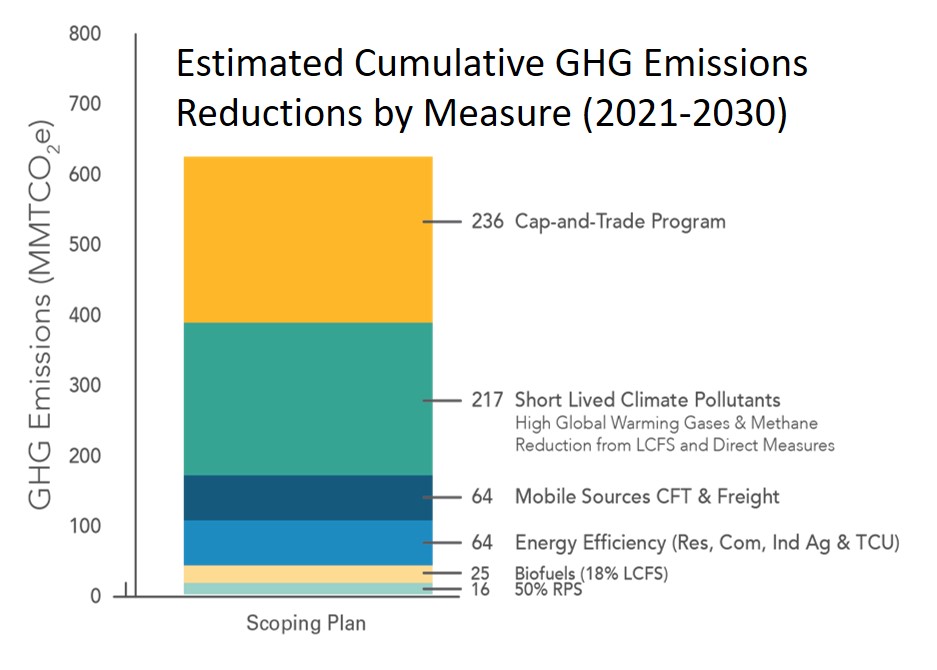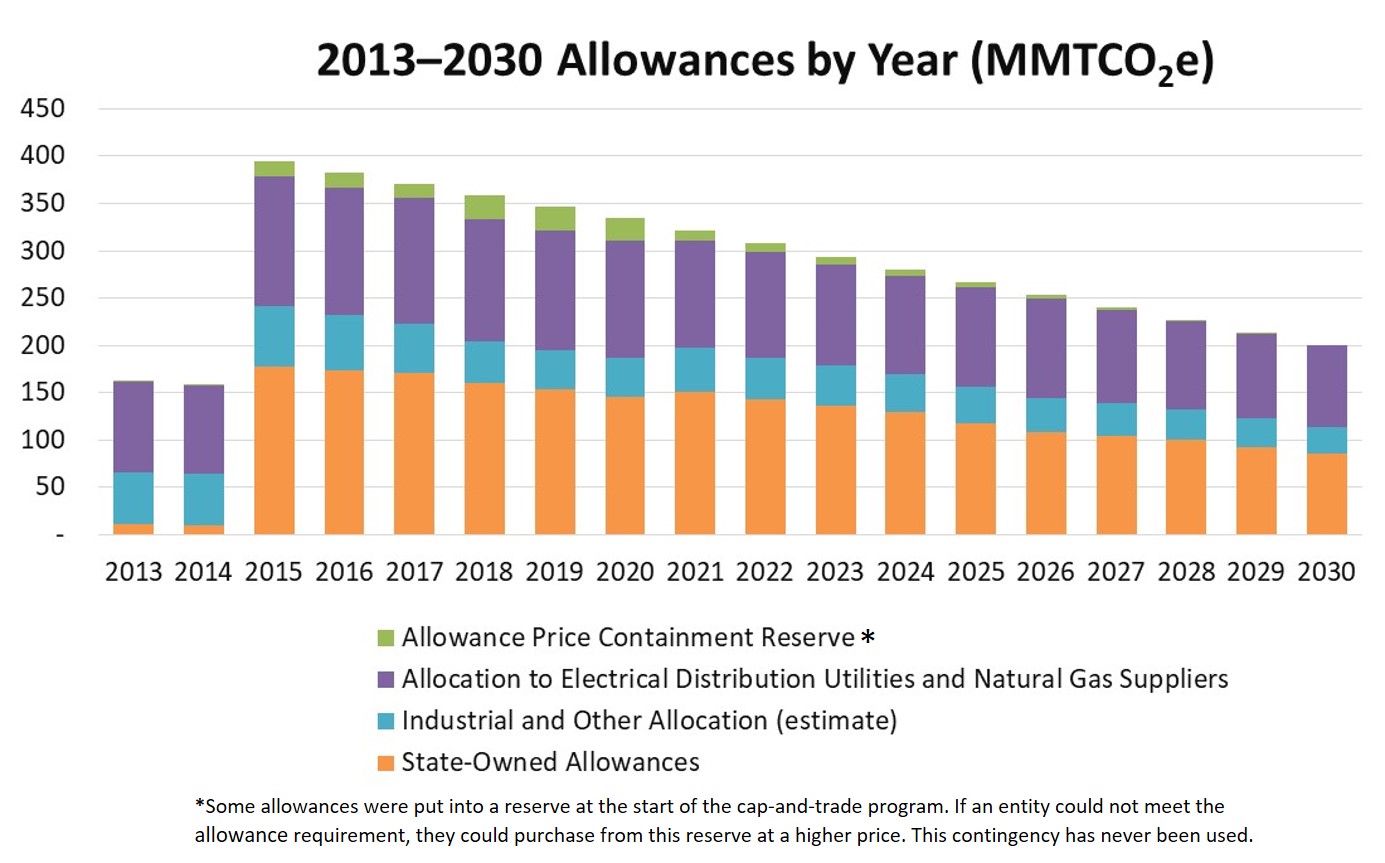California Cap and Trade
On May 9, 2018 PriceonCarbon.org and the League of Women Voters hosted a webinar on California’s Cap-and-Trade program. Presenting were John Gioia, Member of the California Air resources Board (CARB) which administers the cap-and-trade program, and Emily Wimberger, Chief Economist of CARB. The webinar covered principal components of the cap-and-trade system in California and is summarized below. See a recording of the webinar and a copy of California Cap and Trade slides and Helpful Links on California Cap and Trade at the bottom of this page. For more on the history of California’s climate change legislation go here. For an update on most recent carbon pricing actions go here.
California Cap-and-Trade
California has ambitious goals to reduce greenhouse gas emissions. A price on carbon via cap-and-trade is expected to make the largest contribution to those reductions.
California’s goal is to reach 40% below 1990 emissions by 2030, and 80% belo
 w 1990 by 2050. The strategy to do that, outlined in the 2017 California Air Resources Board Scoping Plan, includes a number of complementary measures – from freight, to sustainable community development, energy efficiency, a Low Carbon Fuel Standard, short-lived climate pollutants, and the cap-and-trade program. The measures are designed to work together and complement each other. As you see in the figure, cap-and-trade is an essential piece to meet the emission reduction targets.
w 1990 by 2050. The strategy to do that, outlined in the 2017 California Air Resources Board Scoping Plan, includes a number of complementary measures – from freight, to sustainable community development, energy efficiency, a Low Carbon Fuel Standard, short-lived climate pollutants, and the cap-and-trade program. The measures are designed to work together and complement each other. As you see in the figure, cap-and-trade is an essential piece to meet the emission reduction targets.
The California cap-and-trade program ensures that GHG targets are met by setting an emissions limit – a declining cap – on 85% of emissions, which are primarily emissions from transportation, industry, and electricity generation. Emitters must have sufficient allowances to meet their emissions limit, but how they do that is up to them. The system is not command and control, but rather allows for compliance flexibility and long-term business planning. The price signals motivate long-term investment in cleaner fuel and energy efficiency.
What are Allowances?
One “allowance” allows an entity to emit one metric tonne of CO2 equivalent (methane and nitrous oxide are also controlled in the program; their contribution is calculated as CO2 equivalent). The number of allowances is finite – equal to the cap – and declines over time to meet emission targets. An entity must have sufficient allowances to cover their emissions.
What are Allocations?
Some allowances are “allocated” – given free – to industry and utilities. This is to aid in the transition and not reduce emissions on the back of California economy. Allocations allow businesses to adjust and plan for lower emissions, helping to prevent businesses from going out of state and polluting there instead of in California (called “leakage”). Allocations to utilities give them time to find low cost alternatives to fossil fuels so rate payers are not hit with the cost of high-carbon energy plus allowances. Rather, with time and development of low-emitting, low-cost sources, rates will rise less. Allocations are not permanent; they go down over time.
Allowance Price Containment Reserve: Some allowances were put into a reserve at the start of the cap-and-trade program. If an entity could not meet the allowance requirement, they could purchase from this reserve at a higher price. This contingency has never been used.
Declining Cap: As seen in the figure to the right, the total allowances – including allocations and reserve – decrease with time. Allowances  sold by the state are shown in orange. The total cap declines at 3% per year until 2020, and at 4% per year to 2030. The reason the bars are so low in 2013-2014 is that transportation was not added to the program until 2015.
sold by the state are shown in orange. The total cap declines at 3% per year until 2020, and at 4% per year to 2030. The reason the bars are so low in 2013-2014 is that transportation was not added to the program until 2015.
Purchase and Trade of Allowances: California’s Cap-and-Trade program is linked to programs in Quebec and Ontario. Four times a year allowances from the three partners are auctioned off to covered entities. To maintain a smooth price transition there is a price floor which rises at 5% per year. The allowances sold/purchased are completely fungible whether from California, Quebec, or Ontario. Proceeds are distributed to partners based on the number of allowances each put in to the auction.
Benefits of Larger Market: There are advantages to having partners and to continuing growth of the allowance trading market. For example, in a larger market helps, for with a broad range of industrial sectors, some may be able to reduce emissions at lower cost, helping lower the overall cost of compliance. A larger market helps with liquidity and spreads total cost of compliance more equitably.
Although California is continuing to seek partners and expand the trading market, California’s key goal is to reduce emissions in California, and to see co-benefits of those reductions, such as direct benefits to public health. Further, much is being done to provide benefits directly to disadvantaged communities and/or those most affected by climate change and the efforts to reduce emissions.
Other Design Features: California’s cap-and-trade program allows for multiyear compliance periods so covered entities can buy allowances for future years. Also, allowances can be banked if all are not used in a current year. Offsets are allowed; these are emission reductions, on a tonne for tonne basis, in a sector not covered by the cap-and-trade program. To be accepted, offsets must follow stringent protocols that the offsets be additional emission reductions not required by regulations and that they be verifiable. At this point up to 8% of greenhouse gas emissions can be covered by offsets. That percentage goes down to 4% (2021-2025) and 6% (2025-2030), with further reductions possible.
Revenue Use: To date more than $6.4 billion has been generated for California climate investments. Sixty percent of auction proceeds is currently fixed as follows: 25% for the state’s high-speed rail project, 20% for affordable housing and sustainable communities’ grants (with at least half of this amount for affordable housing), 10% for intercity rail capital projects, and 5% for low carbon transit operations. The remaining 40% must be used to reduce emissions and for other climate mitigation.
Reporting and Enforcement: The Mandatory Reporting Regulation (MRR) is a key component of cap-and-trade. It provides a robust annual reporting and verification mechanism which is consistent across facilities and sectors. Offset projects must comply with CARB-adopted protocols and third party verification. If allowances are not provided sufficient to cover emissions, there is an enforcement penalty four times the allowance cost.
To ensure that the market is fair to everyone, there is an independent market monitor, CARB staff reviews all trades to screen for manipulation, and there are purchase limits and limits to what any one entity can hold preventing stockpiling.
California’s cap-and-trade program is on a solid path. Prior 2017, litigation hampered cap-and-trade. The claim was that cap-and-trade was a tax, which in California requires a two-thirds vote. But in July, 2017 AB 398 passed the legislature with a two-thirds vote and extended the program through 2030.
The key goal of cap-and-trade and complementary measures is to reduce emissions in California. And the plan is working. Emissions are declining. California is on track to meet its 2020 goal and has a doable plan to meet the 2030 goal. So far there has been 99% compliance with cap-and-trade requirements. As the program evolves, CARB will continue to involve stakeholders and the public in administering and improving the program.
Webinar Recording
California Cap and Trade slides
Helpful Links on California Cap and Trade
